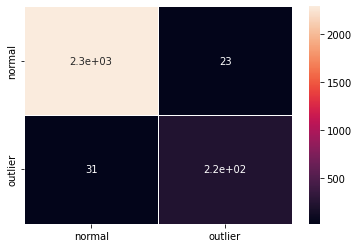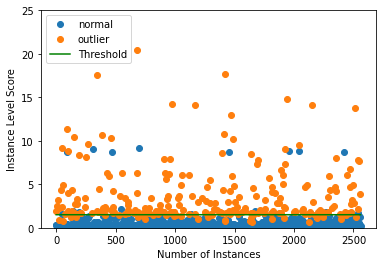This page was generated from examples/od_vae_adult.ipynb.
VAE outlier detection for income prediction
Method
The Variational Auto-Encoder (VAE) outlier detector is first trained on a batch of unlabeled, but normal (inlier) data. Unsupervised training is desireable since labeled data is often scarce. The VAE detector tries to reconstruct the input it receives. If the input data cannot be reconstructed well, the reconstruction error is high and the data can be flagged as an outlier. The reconstruction error is measured as the mean squared error (MSE) between the input and the reconstructed instance.
Dataset
The instances contain a person’s characteristics like age, marital status or education while the label represents whether the person makes more or less than $50k per year. The dataset consists of a mixture of numerical and categorical features. It is originally not an outlier detection dataset so we will inject artificial outliers. It is fetched using the Alibi library, which can be installed with pip. We also use seaborn to visualize the data:
[ ]:
!pip install alibi seaborn
[2]:
import os
import alibi
import matplotlib
%matplotlib inline
import matplotlib.pyplot as plt
import numpy as np
import pandas as pd
import seaborn as sns
from sklearn.metrics import accuracy_score, confusion_matrix, f1_score, precision_score, recall_score
from sklearn.preprocessing import OneHotEncoder
import tensorflow as tf
tf.keras.backend.clear_session()
from tensorflow.keras.layers import Dense, InputLayer
from alibi_detect.od import OutlierVAE
from alibi_detect.utils.perturbation import inject_outlier_tabular
from alibi_detect.utils.fetching import fetch_detector
from alibi_detect.saving import save_detector, load_detector
from alibi_detect.utils.visualize import plot_instance_score
[3]:
def set_seed(s=0):
np.random.seed(s)
tf.random.set_seed(s)
Load adult dataset
The fetch_adult function returns a Bunch object containing the features, the targets, the feature names and a mapping of the categories in each categorical variable.
[4]:
adult = alibi.datasets.fetch_adult()
X, y = adult.data, adult.target
feature_names = adult.feature_names
category_map_tmp = adult.category_map
Shuffle data:
[5]:
set_seed(0)
Xy_perm = np.random.permutation(np.c_[X, y])
X, y = Xy_perm[:,:-1], Xy_perm[:,-1]
Reorganize data so categorical features come first, remove some features and adjust feature_names and category_map accordingly:
[6]:
keep_cols = [2, 3, 5, 0, 8, 9, 10]
feature_names = feature_names[2:4] + feature_names[5:6] + feature_names[0:1] + feature_names[8:11]
print(feature_names)
['Education', 'Marital Status', 'Relationship', 'Age', 'Capital Gain', 'Capital Loss', 'Hours per week']
[7]:
X = X[:, keep_cols]
print(X.shape)
(32561, 7)
[8]:
category_map = {}
i = 0
for k, v in category_map_tmp.items():
if k in keep_cols:
category_map[i] = v
i += 1
Preprocess data
Normalize numerical features or scale numerical between -1 and 1:
[9]:
minmax = False
[10]:
X_num = X[:, -4:].astype(np.float32, copy=False)
if minmax:
xmin, xmax = X_num.min(axis=0), X_num.max(axis=0)
rng = (-1., 1.)
X_num_scaled = (X_num - xmin) / (xmax - xmin) * (rng[1] - rng[0]) + rng[0]
else: # normalize
mu, sigma = X_num.mean(axis=0), X_num.std(axis=0)
X_num_scaled = (X_num - mu) / sigma
Fit OHE to categorical variables:
[11]:
X_cat = X[:, :-4].copy()
ohe = OneHotEncoder(categories='auto')
ohe.fit(X_cat)
[11]:
OneHotEncoder()
Combine numerical and categorical data:
[12]:
X = np.c_[X_cat, X_num_scaled].astype(np.float32, copy=False)
Define train, validation (to find outlier threshold) and test set:
[13]:
n_train = 25000
n_valid = 5000
X_train, y_train = X[:n_train,:], y[:n_train]
X_valid, y_valid = X[n_train:n_train+n_valid,:], y[n_train:n_train+n_valid]
X_test, y_test = X[n_train+n_valid:,:], y[n_train+n_valid:]
print(X_train.shape, y_train.shape,
X_valid.shape, y_valid.shape,
X_test.shape, y_test.shape)
(25000, 7) (25000,) (5000, 7) (5000,) (2561, 7) (2561,)
Create outliers
Inject outliers in the numerical features. First we need to know the features for each kind:
[14]:
cat_cols = list(category_map.keys())
num_cols = [col for col in range(X.shape[1]) if col not in cat_cols]
print(cat_cols, num_cols)
[0, 1, 2] [3, 4, 5, 6]
Numerical
Now we can add outliers to the validation (or threshold) and test sets. For the numerical data, we need to specify the numerical columns (cols), the percentage of outliers (perc_outlier), the strength (n_std) and the minimum size of the perturbation (min_std). The outliers are distributed evenly across the numerical features:
[15]:
perc_outlier = 10
data = inject_outlier_tabular(X_valid, num_cols, perc_outlier, n_std=8., min_std=6.)
X_threshold, y_threshold = data.data, data.target
X_threshold_, y_threshold_ = X_threshold.copy(), y_threshold.copy() # store for comparison later
outlier_perc = 100 * y_threshold.sum() / len(y_threshold)
print('{:.2f}% outliers'.format(outlier_perc))
9.62% outliers
Let’s inspect an instance that was changed:
[16]:
outlier_idx = np.where(y_threshold != 0)[0]
vdiff = X_threshold[outlier_idx[0]] - X_valid[outlier_idx[0]]
fdiff = np.where(vdiff != 0)[0]
print('{} changed by {:.2f}.'.format(feature_names[fdiff[0]], vdiff[fdiff[0]]))
Hours per week changed by -11.79.
Same thing for the test set:
[17]:
data = inject_outlier_tabular(X_test, num_cols, perc_outlier, n_std=8., min_std=6.)
X_outlier, y_outlier = data.data, data.target
print('{:.2f}% outliers'.format(100 * y_outlier.sum() / len(y_outlier)))
9.76% outliers
Apply one-hot encoding
OHE to train, threshold and outlier sets:
[18]:
X_train_ohe = ohe.transform(X_train[:, :-4].copy())
X_threshold_ohe = ohe.transform(X_threshold[:, :-4].copy())
X_outlier_ohe = ohe.transform(X_outlier[:, :-4].copy())
print(X_train_ohe.shape, X_threshold_ohe.shape, X_outlier_ohe.shape)
(25000, 17) (5000, 17) (2561, 17)
[19]:
X_train = np.c_[X_train_ohe.toarray(), X_train[:, -4:]].astype(np.float32, copy=False)
X_threshold = np.c_[X_threshold_ohe.toarray(), X_threshold[:, -4:]].astype(np.float32, copy=False)
X_outlier = np.c_[X_outlier_ohe.toarray(), X_outlier[:, -4:]].astype(np.float32, copy=False)
print(X_train.shape, X_threshold.shape, X_outlier.shape)
(25000, 21) (5000, 21) (2561, 21)
Load or define outlier detector
The pretrained outlier and adversarial detectors used in the example notebooks can be found here. You can use the built-in fetch_detector function which saves the pre-trained models in a local directory filepath and loads the detector. Alternatively, you can train a detector from scratch:
[20]:
load_outlier_detector = True
[21]:
filepath = './models/' # change to directory where model is downloaded
if load_outlier_detector: # load pretrained outlier detector
detector_type = 'outlier'
dataset = 'adult'
detector_name = 'OutlierVAE'
od = fetch_detector(filepath, detector_type, dataset, detector_name)
else: # define model, initialize, train and save outlier detector
n_features = X_train.shape[1]
latent_dim = 2
encoder_net = tf.keras.Sequential(
[
InputLayer(input_shape=(n_features,)),
Dense(25, activation=tf.nn.relu),
Dense(10, activation=tf.nn.relu),
Dense(5, activation=tf.nn.relu)
])
decoder_net = tf.keras.Sequential(
[
InputLayer(input_shape=(latent_dim,)),
Dense(5, activation=tf.nn.relu),
Dense(10, activation=tf.nn.relu),
Dense(25, activation=tf.nn.relu),
Dense(n_features, activation=None)
])
# initialize outlier detector
od = OutlierVAE(threshold=None, # threshold for outlier score
score_type='mse', # use MSE of reconstruction error for outlier detection
encoder_net=encoder_net, # can also pass VAE model instead
decoder_net=decoder_net, # of separate encoder and decoder
latent_dim=latent_dim,
samples=5)
# train
od.fit(X_train,
loss_fn=tf.keras.losses.mse,
epochs=5,
verbose=True)
# save the trained outlier detector
save_detector(od, filepath)
WARNING:tensorflow:No training configuration found in the save file, so the model was *not* compiled. Compile it manually.
WARNING:tensorflow:No training configuration found in the save file, so the model was *not* compiled. Compile it manually.
No threshold level set. Need to infer threshold using `infer_threshold`.
The warning tells us we still need to set the outlier threshold. This can be done with the infer_threshold method. We need to pass a batch of instances and specify what percentage of those we consider to be normal via threshold_perc.
[22]:
od.infer_threshold(X_threshold, threshold_perc=100-outlier_perc, outlier_perc=100)
print('New threshold: {}'.format(od.threshold))
New threshold: 1.505036223053932
Let’s save the outlier detector with updated threshold:
[23]:
save_detector(od, filepath)
WARNING:tensorflow:Compiled the loaded model, but the compiled metrics have yet to be built. `model.compile_metrics` will be empty until you train or evaluate the model.
WARNING:tensorflow:Compiled the loaded model, but the compiled metrics have yet to be built. `model.compile_metrics` will be empty until you train or evaluate the model.
Detect outliers
[24]:
od_preds = od.predict(X_outlier,
outlier_type='instance',
return_feature_score=True,
return_instance_score=True)
Display results
F1 score and confusion matrix:
[25]:
labels = data.target_names
y_pred = od_preds['data']['is_outlier']
f1 = f1_score(y_outlier, y_pred)
acc = accuracy_score(y_outlier, y_pred)
prec = precision_score(y_outlier, y_pred)
rec = recall_score(y_outlier, y_pred)
print('F1 score: {:.2f} -- Accuracy: {:.2f} -- Precision: {:.2f} -- Recall: {:.2f}'.format(f1, acc, prec, rec))
cm = confusion_matrix(y_outlier, y_pred)
df_cm = pd.DataFrame(cm, index=labels, columns=labels)
sns.heatmap(df_cm, annot=True, cbar=True, linewidths=.5)
plt.show()
F1 score: 0.89 -- Accuracy: 0.98 -- Precision: 0.90 -- Recall: 0.88

Plot instance level outlier scores vs. the outlier threshold:
[26]:
plot_instance_score(od_preds, y_outlier.astype(int), labels, od.threshold, ylim=(0, 25))
